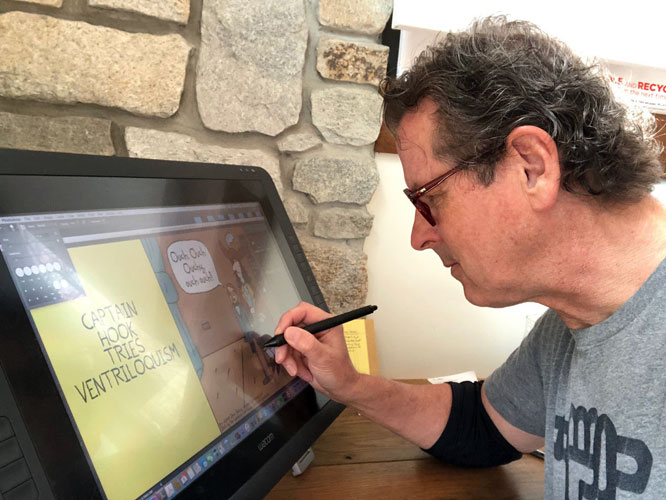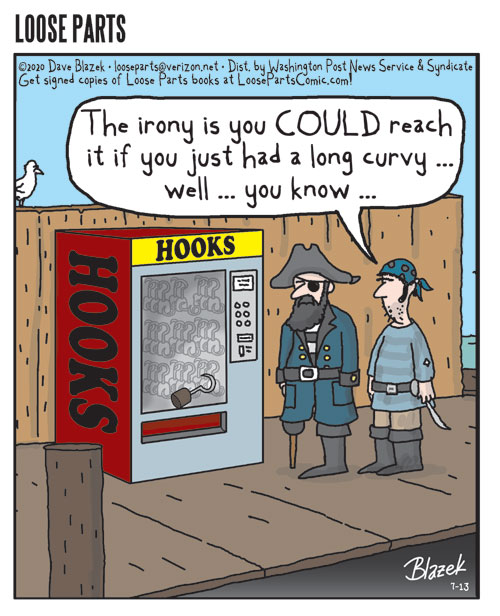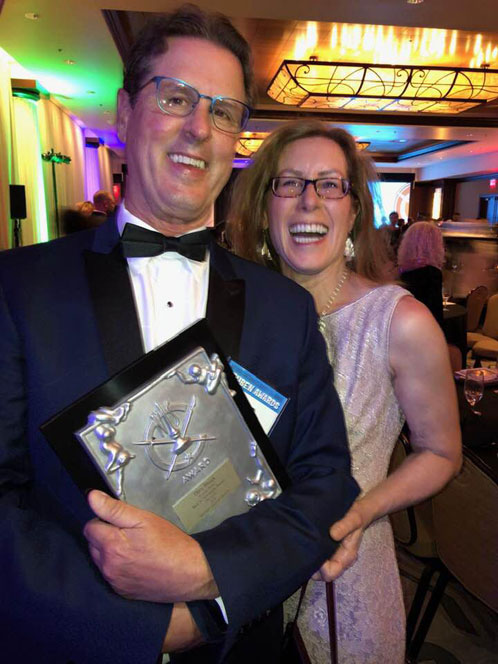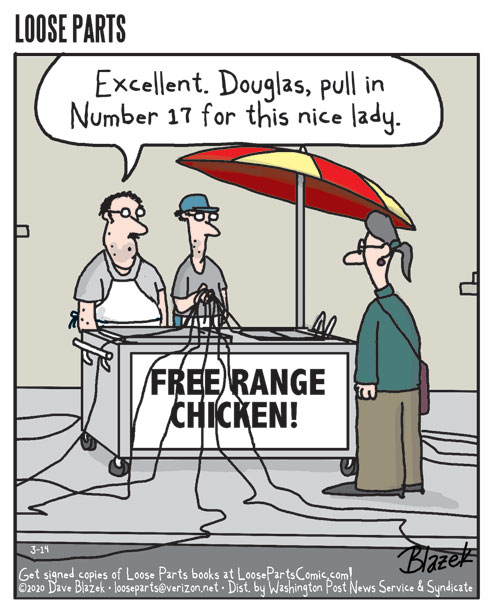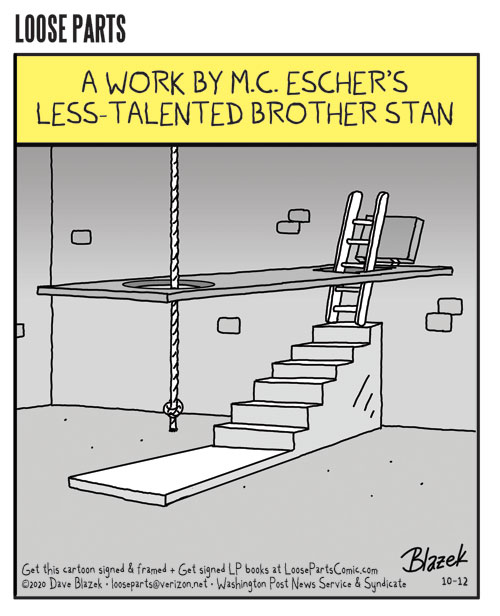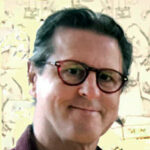Art, // February 28, 2021
Dave Blazek — ARTIST
Interview with artist Dave Blazek —
1. Who are you and what do you do?
I’m Dave Blazek. I’m a cartoonist. Like in newspapers. Like in the Comics section. And yes, there are still many of us around. I produce the comic panel Loose Parts which is syndicated nationally and internationally by the Washington Post. I’ve been doing it for over 20 years now. That’s one cartoon a day, every day, for over two decades. Some 7,300 in a row and counting. I have seven books and have dabbled in animation as well as doing cartoons for businesses and other people who like quirky odd cartoons.
Loose Parts has one the National Cartoonists Society Reuben Award for the nation’s best Newspaper Panel Cartoon the last two years in a row, and has been nominated for that honor 5 times. That award – considered the Oscars of cartooning – are voted on by hundreds of the best cartoonists, illustrators and animators working today … so it’s quite humbling to get that respect from your peers … most of whom are more talented than I am.
Perhaps the weirdest part of this journey is that I never grew up wanting to be a cartoonist. Never drew or doodled. In fact, I only learned to draw in my 40s when an unusual opportunity to get into this world presented itself to me. I was working as a Creative Director at The Philadelphia Inquirer, and doing standup comedy on the side, when the paper’s editors began soliciting my opinions on the Comics page submissions coming in from syndicates. I kept saying they weren’t funny so they challenged me to try it myself. So, I recruited an artist buddy and we created Loose Parts in a weekend – with me writing all the gags and he doing the art. Before we knew it the Los Angeles Times Syndicate signed us to a contract and Loose Parts was born. Alas, in the first year, my artist partner got sick and had to drop out. So, rather than lose this new cartooning gig I had quickly grown fond of, I asked the syndicate if I could draw Loose Parts as well as write it. They said yes. I hung up the phone and said, “My God, what have I done?” I had to learn to draw quickly, and on the fly as I had holes in newspapers all over to fill. So that was my incredibly unusual immediate immersion into becoming an artist.
But now, some 7,000 pieces of art later, I can draw. And yes, it’s all still as shocking to me as it sounds to you.
2. Why Art?
Well, I’ve always been in creative fields – from advertising to comedy – so that ‘thing’ inside you that must come out has always been there. And a few decades of creating funny ad campaigns (I’ve written and directed some 125 TV commercials and over 500 radio commercials) I was just waiting for the right hole to open up and let the art out. As it happens, cartooning is the exact thing that meshes with my brain. Mostly, because it’s a combination of writing and art and deadline work that I crave. The challenge of being professionally clever is indeed an intoxicating one. I must say that becoming an artist in middle age had its advantages. I was much more conscious of the process. And I was surprised by the sheer joy of the act of drawing – the feeling of pencil on paper and the whole iterative process. The sheer enjoyableness of the act itself is very gratifying. It’s a great way to spend time. And it’s proven to be a great way to be involved in the creative world for many many years to come. Even more so since I retired from my newspaper career just a few years ago. Yes, I did a daily cartoon for 18 years while working a full time job. It was, let’s say, interesting.
3.What Is Your Earliest Memory of Wanting To Be An Artist?
If you define ‘artist’ as wanting to make a living in the creative world, I’d have to say that crystallized during my college years. I went to Penn State and got a degree in Journalism with the goal of being a newspaper reporter. But I spent a great deal of time on other activities there such as TV production and, most important, as the editor of the Froth the humor magazine at the school. That’s where I fell in love with creating funny things and watching people react to them. It’s a hard feeling to describe. But it made me want to do something in the media even if I soured on being reporter.
But the path, as it is for so many artists, wasn’t a straight one. It included a few years working in a factory and selling advertising to used car dealers before I could latch on to a newspaper career. I just tried to tackle every task I was assigned in a way it had never been done before. People noticed and my advertising career grew to where I had received over 120 awards including Clios and ADDYs. And all of that put me in a position to be ready when the cartooning fairy came knocking.
4. What are your favorite subjects and methods?
Well, my subjects are everything in the universe and then some. Loose Parts has no recurring characters. Each day is a new gag. Think of Gary Larson and The Far Side. That allows me to roam everywhere and access everything. It’s very important when you do a new cartoon every single day.
And my methods? I work out of my lovely second-floor studio right on the edge of Valley Forge Park just outside of Philadelphia. We built the space a few years back to serve as a broad creative space. So not only do I draw there, my wife uses it to oil paint and woodwork. And we use it (in non-pandemic times) to gather friends and play music together. It is my favorite place in our house.
Not being a trained artist, I knew nothing of tools or methods. So my earliest cartoons were scratched out on copier paper with a mechanical pencil. Then scanned into my computer and completed in Photoshop. Six or seven years ago, I went all-digital. I now draw directly on a 24” Cintiq screen. And finish off my work using Photoshop. I do each cartoon in both Color and in Black & White. And I also do each in panel and strip configuration. And I do complete color plate separations and coloring for each Sunday cartoon … also in two shapes. That means each month, I send my syndicate, yes, 120 separate final pieces of art to go out to newspapers. Sounds like fun, doesn’t it?
Going digital allows me to remove the tracing, inking and scanning from the process and leaves me more time create.
Of course, the root of it all comes from the ideating process. So each week, I block out a few hours, usually on a Sunday or Monday, and just sit and write jokes. I’d love to paint a magical picture of that, but it mostly involves sitting and staring off into space while smashing concepts together into something that falls out. It’s kind of like the Hadron Collider without the damaging radiation. Having started out as a writer and comedian really gave me a leg up. I can write a dozen jokes in about 90 minutes. Then I end up tossing a bunch of those to get down to the seven I draw every week.
I do work months ahead. My syndicate has finished cartoons about three months out. I always have another month of drawings done on top of that. And on top of that, I have about two or three weeks of jokes waiting to be drawn. You have to stay in front of the wave or it will swallow you and spit you out.
5. How do you approach your subjects?
Carefully, and in a hazmat suit. Truth is, I could write a much longer treatise on idea generation. But in short, it involves lowering the wall in your brain that keeps disparate subjects separate. The quicker you can train yourself to be open to things that don’t usually go together, the quicker you’ll get to making something no one has seen before.
But I’m also a big proponent of Chuck Close’s famous quote, “Inspiration is for amateurs.” Pros go to work, every day. And out of that process, inspiration comes. I go to work every day.
6.Who are your favorite artists?
It’s pretty obvious I come from the Gary Larson Far Side tree. But that tree has roots of B. Klban and Charles Addams and all the great old New Yorker cartoonists. I admire and try to absorb them all. It’s a little crowded but it works. But I also pull from the comedy world and comedians like Steven Wright, Mitch Hedberg, Demetri Martin and the pros everyone knows, Jay Leno, Seinfeld, Steve Martin, etc.
And there’s a current group of panel cartoonists who bring the goods every day, and that keeps me on my toes. That list included Dave Coverly, Dan Piraro, Wayno, Mark Parisi, Hilary Price, Dave Whamond and several more. This type of cartooning – the quirky single panel – is quite vibrant these days. I encourage you to get a newspaper and check out the work being done.
7. What are the best responses to your work?
The thing I hated most about cartooning when I got into it in the 1990s was the lack of immediate response – especially when compared to the instantaneous response you get doing standup comedy. But now, with social media, you can share and see responses to your work that day. I try to challenge my readers with jokes that sometimes take a little figuring out. And it’s fun to be able to reach them via these pathways.
I also sell signed framed prints of my cartoons. And it’s gratifying to know that someone somewhere like my cartoon enough that they want to hang it on the wall in their home or office, like a piece of fine art. It’s immensely warming.
8. What do you like best about your work?
Oh so much. The physical aspect of drawing. The conjuring of ideas. The mixture of thinking and entertaining. The challenge to see just how many ideas there are still out there. And of course, the clothes. Don’t forget the clothes. Also, having started as an adult, I’m still energized and enthralled and still see the magic in it all. I’m far away from burning out.
Also, I’ve always had a deep love of newspapers, and cartooning allows me to be deeply intertwined with that enterprise. As a young journalism student, I dreamed of seeing my byline in the Washington Post. The fact that I do now appear in the Post every day, but in the Comics, is weirdly wonderful. Being with the syndicate brought me to my editor Amy Lago, who was Charles Schulz’s editor. She recruited me to the Post Syndicate … which probably right there should make you question her judgement.
9. What advice would you give to other artists?
First, there’s no mailing it in. You gotta do the work. You have to get to it and start producing as if you were a working pro already. You don’t have to. But there are people out there who will when you won’t, and that’s who you’re going to end up going up against. You’re gong to have to sacrifice time and money on the front end with hopes of making just enough to keep it interesting on the back end. That’s just the reality of the business as it is. In summary, do it because you love it and enjoy whatever money you make off of it as a business.
10. Where do you see yourself in 10 years?
I see myself doing this as long as people will have me. The technology and delivery systems may change – and it’s important to stay on top of that – but the power of a good joke and a brilliantly concise drawing still needs to be harnessed. I still think I can get better. Every year, I try to write a little longer, redraw more often and spike more cartoons than ever before. I keep trying to distill the cartoons I do down to the very best ones I can do before I share. That’s a long road yet to travel … and a lot of space to improve in.
LINKS —
• See Dave Blazek’s cartoons, see his studio, learn more about him and even see videos of cartoons being drawn at: LoosePartsComic.com
• Buy signed books of Blazek’s cartoons, signed custom framed cartoons and greeting cards at: The Shop page at LoosePartsComic.com
Facebook: https://www.facebook.com/dave.blazek



